本文共 6314 字,大约阅读时间需要 21 分钟。
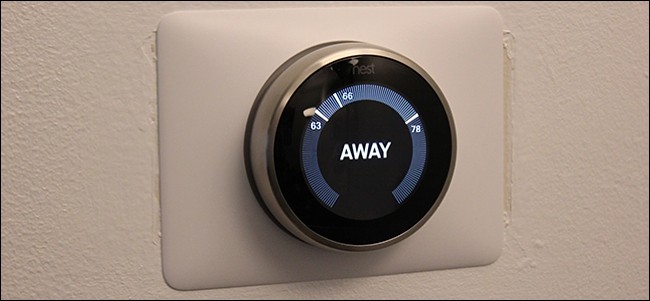
When you leave for work, you likely turn down your thermostat before you head out the door to save energy. But the Nest Thermostat can automatically do that for you, by detecting when you’re away and when you come home.
当您去上班时,可能在出门前先关闭恒温器,以节省能源。 但Nest Thermostat可以通过检测您何时离开和何时回到家来自动为您执行此操作。
With a feature called Home/Away Assist, the Nest Thermostat can use its built-in sensor, as well as the GPS location from your phone, to automatically determine whether you’re home or away. From there, it can turn down the temperature if you’re away and turn it back up when it detects that you’re coming home. Here’s how to set it up.
借助称为“居家/外出协助”的功能,Nest Thermostat可以使用其内置传感器以及手机的GPS位置来自动确定您是在家还是不在。 从那里开始,它可以降低温度(如果您不在的话),然后在检测到您要回家时重新升高温度。 设置方法如下。
主场/客场助攻vs.自动客场 (Home/Away Assist vs. Auto-Away)
First off, it’s important that we clear up something that might be confusing you. The Nest Thermostat has two features along these lines: one called Home/Away Assist, and one called Auto-Away, both of which seem very similar to one another. Auto-Away has been around for a long time, while Home/Away Assist is a fairly new (and long-awaited) feature.
首先,重要的是我们要清除可能使您感到困惑的内容。 Nest Thermostat在这方面具有两个功能:一个称为“居家/离开”辅助功能,另一个则称为“自动离开”功能,两者看起来非常相似。 Auto-Away已经存在了很长时间,而Home / Away Assist是一项相当新的功能(期待已久)。
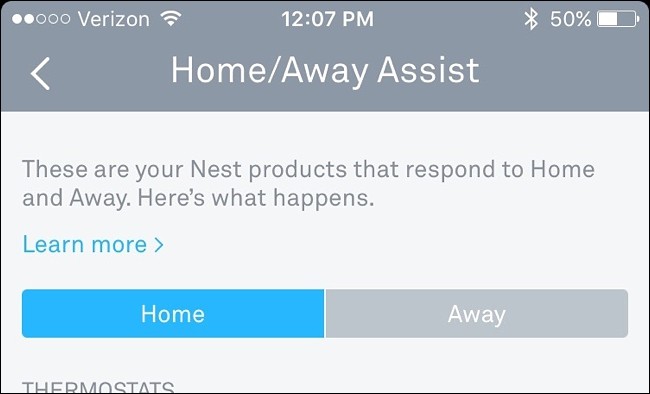
The biggest difference, though, is that Auto-Away is exclusive to the Nest Thermostat, while Home/Away Assist is available on all of Nest’s products (Nest Cam, Nest Protect, and so on). Furthermore, Auto-Away on the Nest Thermostat only uses the unit’s motion sensor to detect whether or not anyone is home, while Home/Away Assist uses your phone’s GPS, as well as the motion sensor, resulting in more accurate detection, so to speak.
不过,最大的区别在于,Nest Thermostat专用于Auto-Away,而Nest的所有产品(Nest Cam,Nest Protect等)都可以使用Home / Away Assist。 此外,Nest Thermostat上的Auto-Away仅使用本机的运动传感器来检测是否有人在家,而Home / Away Assist则使用手机的GPS和运动传感器来进行更精确的检测。 。
However, in order for Home/Away Assist to use the sensor portion, Auto-Away must be enabled, so you could look at Auto-Away as being a part of the Home/Away Assist feature. Neither has to be enabled for the other to work, but if you want your Nest to use both the GPS and the motion sensor, you’ll want to turn both on.
但是,为了使Home / Away Assist使用传感器部分,必须启用Auto-Away,因此您可以将Auto-Away视为Home / Away Assist功能的一部分。 两者都不需要启用才能使对方正常工作,但是如果您希望Nest同时使用GPS和运动传感器,则需要将两者都打开。
Now that we have that cleared up, let’s get started setting up Home/Away Assist so that your Nest Thermostat can automatically adjust itself based on your home/away status.
现在,我们已经解决了这一问题,让我们开始设置“居家/出门助手”,以便您的Nest Thermostat可以根据您的居家/离开状态自动进行自我调整。
如何设置家庭/外出协助 (How to Set Up Home/Away Assist)
Start by opening up the Nest app on your phone and tapping on the settings gear icon in the top-right corner of the screen.
首先打开手机上的Nest应用,然后点击屏幕右上角的设置齿轮图标。
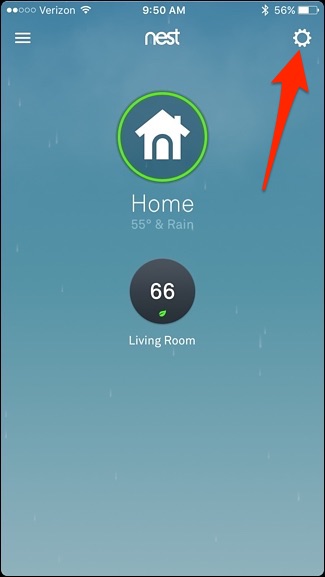
Select “Home/Away Assist”.
选择“家庭/外出协助”。

Tap on “What decides if you’re home”.
点击“决定您是否在家的决定”。
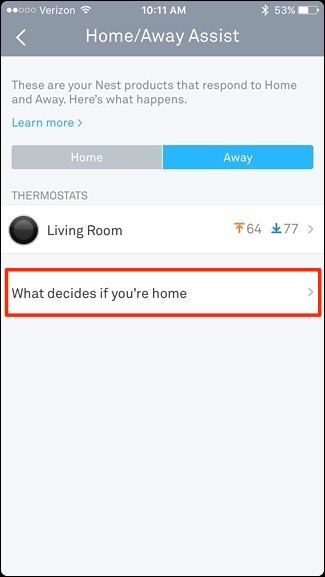
Tap on “Use phone location”.
点击“使用电话位置”。
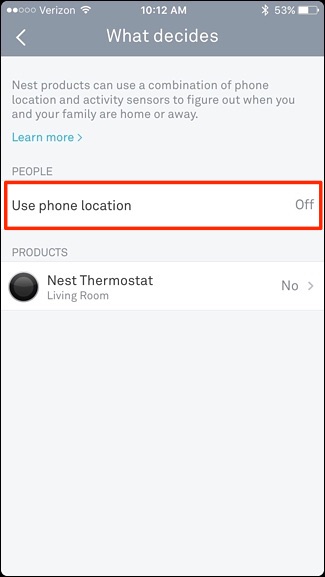
Tap on the toggle switch that appears.
点击出现的切换开关。
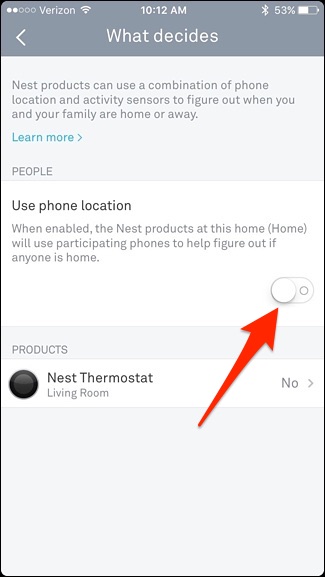
A new screen will pop up. Tap on “OK” at the bottom.
将会弹出一个新屏幕。 点击底部的“确定”。
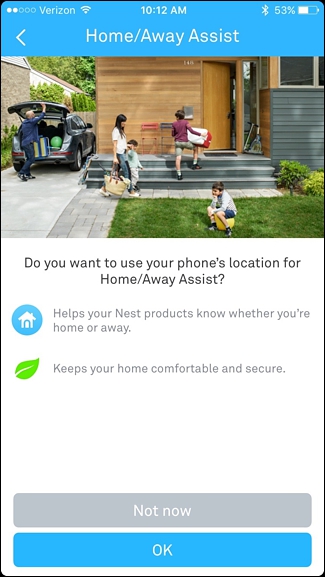
When a smaller pop-up appears, tap on “Use phone”.
当出现较小的弹出窗口时,点击“使用电话”。
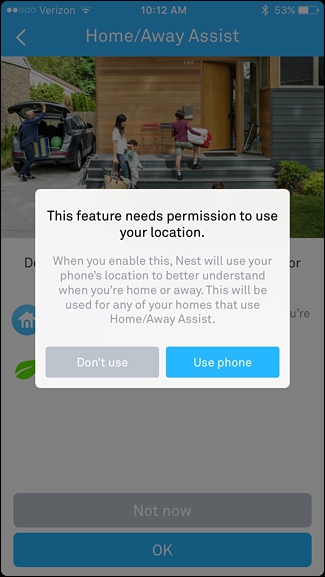
You might get another pop-up asking permission for the Nest app to access your location. Accept this if you get this message.
您可能会看到另一个弹出窗口,要求Nest应用访问您的位置。 如果收到此消息,请接受。
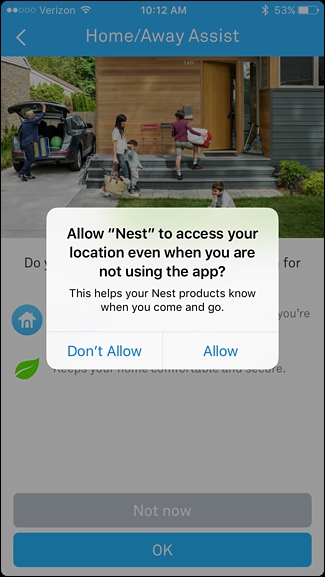
On the next screen, enter in your address and tap on “Next”. Don’t worry, though: Nest doesn’t save this address anywhere–it’s simply just used to find your location on the map and make it easier to pinpoint your location.
在下一个屏幕上,输入您的地址,然后点击“下一步”。 不过,请放心:Nest不会在任何地方保存该地址-只是用来在地图上找到您的位置,使查明位置变得更加容易。

When the next screen appears, drag the map to move the pin on top of your house. You can tap on the mountain icon in the bottom-right corner to get an overhead satellite view. Tap on “Done” when it’s set.
当出现下一个屏幕时,拖动地图以将图钉移到房屋顶部。 您可以点击右下角的山峰图标,以俯视卫星视图。 设置完成后,点击“完成”。
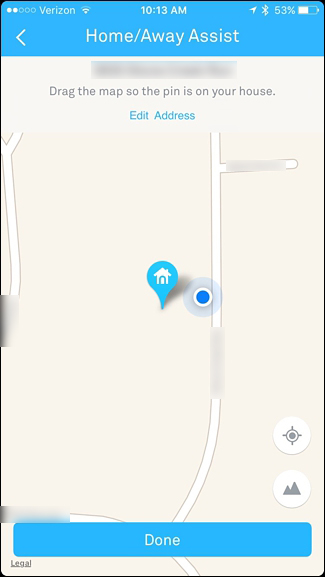
The next step is to enable Auto-Away, which uses the Nest Thermostat’s built-in motion sensor to determine if you’re home or away. Tap on the toggle switch to the right of “Nest Thermostat” and select “Next”.
下一步是启用“自动离开”功能,该功能使用Nest Thermostat的内置运动传感器来确定您是在家还是不在。 点击“嵌套恒温器”右侧的拨动开关,然后选择“下一步”。
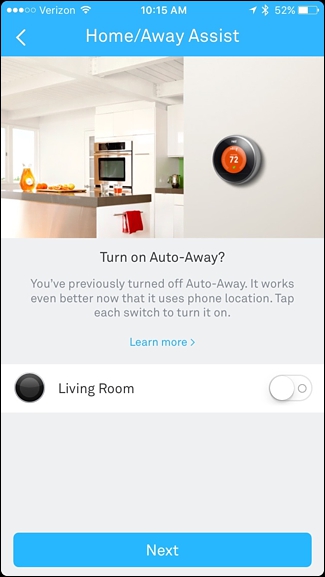
Tap on the back arrow in the top-left corner of the screen.
点击屏幕左上角的后退箭头。
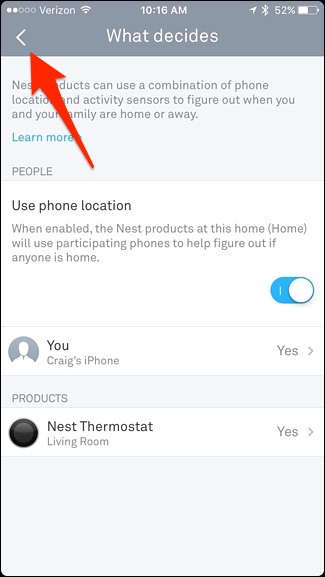
Next, tap on the two temperatures that are displayed with the small orange and blue arrows.
接下来,点击带有橙色和蓝色小箭头显示的两个温度。
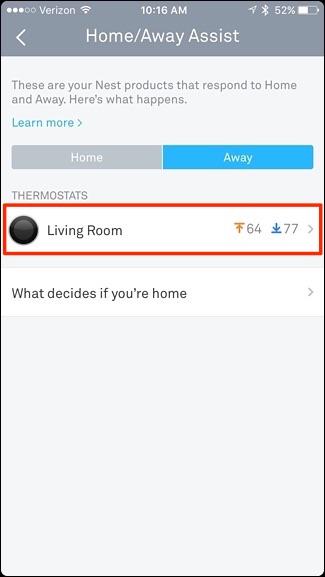
Under “Use Away temperatures”, you can hold and drag on the two dots to set your minimum and maximum comfort temperatures. These are called Away Temperatures, and depending on how you have them set, your Nest Thermostat will automatically turn on your heating or air conditioning to meet these specified temperatures.
在“使用温度”下,您可以按住两个点并拖动以设置最低和最高舒适温度。 这些称为“离开温度”,根据您的设置方式,Nest Thermostat会自动打开供暖或空调以满足这些指定温度。
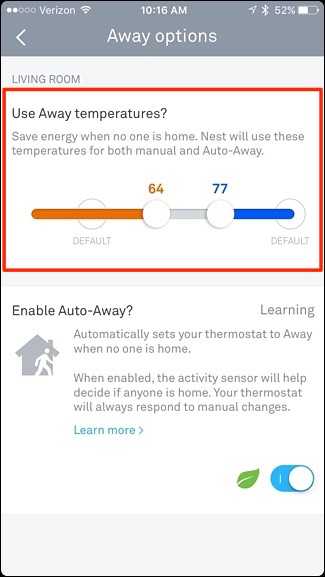
For example, if your thermostat is set to Away, but you still want the heat to kick on if the temperature inside your house ever reaches 65 degrees, you can set it so that the heat will kick on automatically whenever it gets that cold in your house. Or if the temperature reaches 80 degrees inside in the summer, but you don’t want it to get any hotter, you can set this as the maximum temperature.
例如,如果您的恒温器设置为“离开”,但如果您的房屋内温度达到65度,但您仍希望加热,则可以进行设置,以使加热到您的寒冷时自动加热。屋。 或者,如果夏天夏季温度达到80度,但又不想再变热,可以将其设置为最高温度。
After you set these temperatures, you can hit the back arrow in the top-left corner to go back to the main screen. At that point, you’re set to go!
设置好这些温度后,您可以点击左上角的向后箭头以返回主屏幕。 到那时,您就可以出发了!
If you don’t want to use either the GPS or the Nest’s motion sensor, simply skip those specific steps above, but having both enabled will allow your Nest Thermostat to do a better job at automatically determining whether you’re home or away. In fact, if you only have the motion sensor portion enabled, it will take about a week or so for the Nest Thermostat to learn your daily patterns and adjust itself efficiently.
如果您不想使用GPS或Nest的运动传感器,只需跳过上面的特定步骤,但是同时启用这两个步骤将使Nest Thermostat可以更好地自动确定您是在家还是不在。 实际上,如果仅启用运动传感器部分,则Nest Thermostat大约需要一周左右的时间来学习您的日常模式并有效地进行自我调整。
Furthermore, if you have an erratic schedule and don’t leave and come home at the same times every day, it might be best to have GPS enabled so that the motion sensor doesn’t get overly confused.
此外,如果您的日程安排不规律,并且不想每天都在同一时间离开家,那么最好启用GPS,这样运动传感器就不会太混乱。
翻译自:
转载地址:http://yxbwd.baihongyu.com/